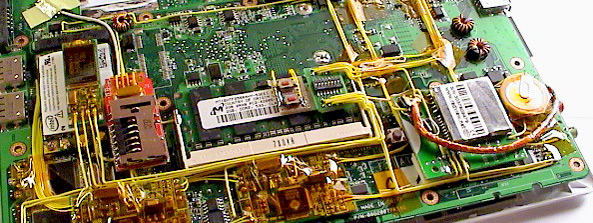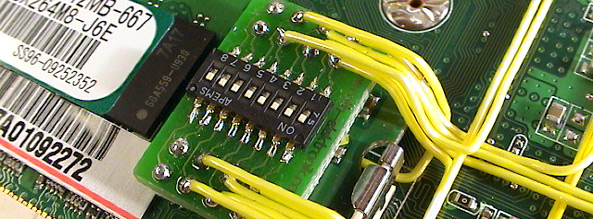» Eee PC
By ivc at 18:07, December 31, 2007

The Asus Eee PC is a lot of fun. Mostly because of the size and the room for modifications.
It’s in the same realm as the OLPC/XO machine, sub-$400 market. By default the Eee PC sports a Celeron M 900 MHz processor, 512 MB memory, 7-inch 133 dpi 16:9 display, 4 GB Solid State Disk-drive, wireless networking, ethernet, webcam, SDHC card reader, 3 USB ports, and a 5200 mAh 4-cell Li-Ion battery.
Opening the machine reveals a exhaust fan, only mechanically rotating part in the machine, and an empty Mini PCI-Express expansion bay (header only installed on initial machines). The expansion bay can be used for internal upgrades like Bluetooth and flash drives.
I wanted to see how much and how far I could take the Eee PC. After a few weeks of planning and researching devices, I can up with a this list of internal upgrades:
- USB hub (2x)
- GPS module with gain antenna
- Bluetooth
- Internal card reader
- Fast flash drive
- FM transmitter
- Draft-N wireless adapter
- Switch for power management
Everything fitted and works perfectly after some initial tweaking. Although the battery time is cut with an hour when all the devices are powered on, I can easily disable the ones I don’t use through a DIP-switch in the expansion bay.
Update: During my trip to Newcastle I was checking Digg.com and noticed that my wiki page about the Eee modifications was promoted to the front page. That was a nefarious and cool moment. A week and a half later, Slashdot picked it up too. Found one of my favorite sites, Ars Technica, found time to post an article about the Eee modifications.

 Some Rights Reserved 2006-2025 ivc
Some Rights Reserved 2006-2025 ivc
[…] Here’s another interesting post I read today by ivc blog […]
December 31st, 2007 at 18:54Wow, that’s a load of work. I’m *very* interested in the GPS receiver specs, or at least the board layout. the fact there’s a serial-usb chip on there means I should be able to pull a straight serial connection off, no? I have a lod of possible uses for that. Any chance you could bung up some hires photos of the board, if you have them?
January 23rd, 2008 at 14:24[…] Um individuo (nome pendente, o ser vivo não expõe seu nome em lugar algum, provavelmente Ivan) com muita imaginação, tempo, dinheiro e as ferramentas certas, resolveu fazer algumas modificações em seu Asus Eee PC. […]
January 23rd, 2008 at 20:34Hi Ian,
Stumbled upon your little hack by chance .. very impressed by how much you could stretch the Eee PC! I wonder how much further this PC can be pushed.
What would you say is the top 5 components that consume the most battery. I assume that #1 would be LCD display, so that aside, any wild guesses on which one drains the batt life the most? There’s no moving parts, right?
January 25th, 2008 at 09:01Hi, I don’t really know but the screen, cpu, chipset, fan, and memory would drain a fair amount of power.
January 25th, 2008 at 12:47I wonder if the screen can be swapped out for an E-ink monochrome screen. That would save a lot of power. I’m just wondering if Eee PC can be modded enough to reduce power consumption levels that might come close to the OLPC.
January 26th, 2008 at 06:52Could you post some data on the FM transmitter, like what its called and where to buy?
January 30th, 2008 at 13:50Dan: I think I have, it’s called Airplay and I got it off Ebay.
January 30th, 2008 at 13:57hi, i cannot wrap my head around how you did the USB soldering in the first place (USBx to hub and back), can you provide a diagram / pix? i love the idea of having 3 or even 6 more internal USBs, but i cannot figure out the cable layout to begin with. Seems like you draw the power from a random place and reroute ground to the nearest GND, taking the signal lines from the outlet for the external slot, but how do you reattach the original external slot? Thanks in advance!
February 14th, 2008 at 05:29MikeTango: It’s simple really, the USB-ports on the right side, I cut the connection half-way. Connecting the tracers from the motherboard chipset to the new internal USB-hub. And then from the USB-hub, I connected two wires back to the half-way cut wires that goes all the way to the right side USB ports. One USB-hub used for each USB-port.
February 14th, 2008 at 11:20